January 31st, 2007
Here is an updated picture of my 20 long tank in my office. Last week I noticed that one of the female apistogramma borellii had turned bright yellow. I haven’t seen any fry yet, but then again, I haven’t really seen the female fish either. There’s still a school of about a dozen male Endlers in here as well.
 Â
Â
The plants in this tank are rotala macrandra ‘green’, rotala indica ‘red’ (or rotala colorata), Crasula helmsii, Ranalisma rostrata, marselia quadrafolia, and Heteranthera zosterifolia. I’m finally starting to win the thread algae battle in this tank. Over the previous month or two this tank had a mess of 8″ long thread algae flowing in the current. My brother commented that at least I’m able to grow “cool looking algae,” but I wasn’t amused. Thankfully, thanks to a strict SeaChem-only dosing schedule with Excel overdoses, I’m now in control.
Maybe one of these days I’ll properly trim these stem plants. I hate growing stem plants in a 12″ tall tank! At least I like the rockwork!
Posted in 20L Tank Log | Comments Off on 20G Long – Updated Photo
January 29th, 2007
 On Saturday, I attended GWAPA’s first meeting of the new year. The topic of the meeting was about low-tech aquariums, meaning, aquariums without CO2, high light, or excessive dosing. Since most of my tanks are fairly high-tech, it’s always good for me to remember that folks can maintain really nice planted aquarium at a fraction of the cost or effort that I do. My 54G tank is my only real low-tech tank that I try to keep looking nice, and it’s amazing how many guest we have over that marvel over that particular tank, and then hardly mention the other ones. I tell myself that it’s simply due to the low-tech tank being near the entranceway of our home.
On Saturday, I attended GWAPA’s first meeting of the new year. The topic of the meeting was about low-tech aquariums, meaning, aquariums without CO2, high light, or excessive dosing. Since most of my tanks are fairly high-tech, it’s always good for me to remember that folks can maintain really nice planted aquarium at a fraction of the cost or effort that I do. My 54G tank is my only real low-tech tank that I try to keep looking nice, and it’s amazing how many guest we have over that marvel over that particular tank, and then hardly mention the other ones. I tell myself that it’s simply due to the low-tech tank being near the entranceway of our home.
Anyway, the meeting was great. It looks like it’s going to be a great year for GWAPA with lots of stuff in the works. The “mini” auction of not really mini at all, and I came away with some great plants to try. I managed to snag Crasula helmsii, a fine-leaved, creeping foreground plant, crypt. molmanei (for my 54G anubias/crypt tank), and a bag of HC since I still haven’t tried that yet.
Finally, I had my first opportunity to get out of the house to test my new camera, the Canon Rebel XTi. I have a lot to learn, but I really like how this camera is working so far. The pictures of Viktor’s rainbowfish are using my 17-85mm zoom lense.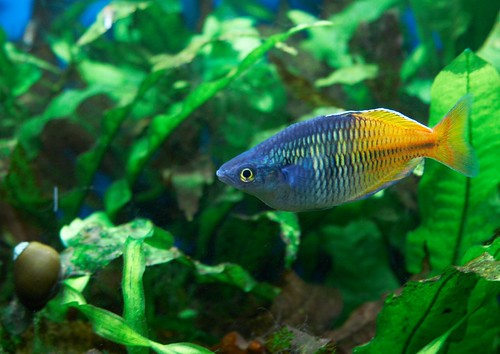
Posted in GWAPA | Comments Off on GWAPA January 2007 Meeting
January 19th, 2007
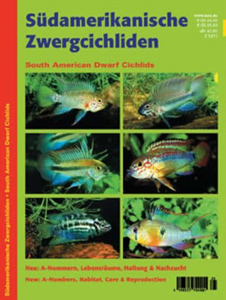 A few weeks ago, I came across this post on one of the cichlid forums, offering a dual language (English/German) version of a special DATZ publication on South American Dwarf Cichlids. I decided to contact the poster, Mike Wise, who consequently is the person who did the actual translation work from German to English, and is now selling copies of the book himself to folks in the United States.
A few weeks ago, I came across this post on one of the cichlid forums, offering a dual language (English/German) version of a special DATZ publication on South American Dwarf Cichlids. I decided to contact the poster, Mike Wise, who consequently is the person who did the actual translation work from German to English, and is now selling copies of the book himself to folks in the United States.
This week, I received the book, and boy am I impressed. This doesn’t have the extensive information that the Cichlid Atlases have on each species, but as a simple photo log for hundreds of apistogramma or other dwarf species, with general locality information, it’s tremendous. Most species have multiple photographs, showing possible color morphs, and noting differences between different A-numbers currently attributed to the same species name. The book is organized sequentially by A-number, but the index is very comprehensive, listing both Latin and common names for fish, so they’re easy to lookup.
My only complaint for this book is that it doesn’t list pH or TDS information for each species. That said, I realize that this information is not necessarily available for every species, and even if it were, might fluctuate greatly depending on the wet/dry season.
All in all, this is a very dangerous book. It’s easy to flip through the pictures, and find some amazing species that you would like to try in your tank. I imagine many of these are hard or impossible to find unless you go collect them yourself, but it’s great to peruse nonetheless.
You can get a sample of some of the book’s pages here.
Posted in Books, General | 3 Comments »
January 17th, 2007
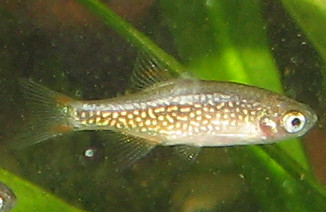 After work today, I decided to drop by the House of Tropicals since I haven’t been there in a few months. It didn’t hurt that I had a couple of gift certificates to spend there from Christmas. I had planned to just pickup some supplies and fertilizers, but I had to first do my obligatory walk through all of the fish aisles. In one of the aisles I came across a tank full of galaxy rasboras. I hadn’t previously seen these fish in person, but I’ve certainly heard plenty about them. I marveled at the tank for a bit, and then moved on. Shortly thereafter, I came across another tank of slightly smaller galaxy rasboras priced at just $3.98/fish. Well, I know most LFS’ sell these fish for around $10/fish, so I decided to jump on them.
After work today, I decided to drop by the House of Tropicals since I haven’t been there in a few months. It didn’t hurt that I had a couple of gift certificates to spend there from Christmas. I had planned to just pickup some supplies and fertilizers, but I had to first do my obligatory walk through all of the fish aisles. In one of the aisles I came across a tank full of galaxy rasboras. I hadn’t previously seen these fish in person, but I’ve certainly heard plenty about them. I marveled at the tank for a bit, and then moved on. Shortly thereafter, I came across another tank of slightly smaller galaxy rasboras priced at just $3.98/fish. Well, I know most LFS’ sell these fish for around $10/fish, so I decided to jump on them. I snatched up 18 fish, got my 10% club discount, and came home.
I snatched up 18 fish, got my 10% club discount, and came home.
I had to clean out one of my 10G tanks of all (or as many as I could catch) of the Endlers that were in there, to make room for the new rasboras. I don’t know a whole lot about these fish, but apparently they need soft water, pH in the 6.3-7.3 range and 10 dH. Those parameters aren’t too far off from my tap water, so hopefully they do just fine with that. I need to figure out what to feed them. A few Internet sources say that small live foods are preferable. I have blackworms on hand, but they may be too large for them right now. I’ll have to hatch out some baby brine shrimp. If anyone knows anything else about these cool fish, please comment.
Posted in Fish Profiles | 5 Comments »
January 15th, 2007
I had my camera and tripod out last night, so I decided to snap a picture of my 54G corner tank. This scape doesn’t change too much, but that’s a good thing. As a reminder, there’s no CO2 on this tank, and the light is mostly deflected some the Phyllanthus Fluitans floating on the surface. I have an Eheim Liquidoser on top of the tank that dumps in a few milliliters of PMDD every day, but otherwise I don’t supplement this tank with anything more than fish food.
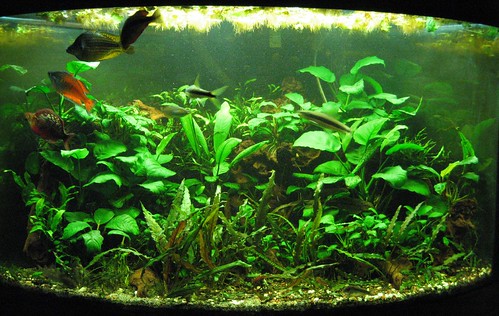
Posted in 54G Tank Log | Comments Off on Low-tech 54G – Updated Photo
January 13th, 2007
 I attended the Capital Cichlid Association’s January meeting today, where Michael Barber, a club member, talked about his experiences collecting fish in Iquitos, Peru. I have an extra sense of interest about this topic because my wife and I are contemplating a similar trip this year through Margarita Tours, to see the Amazon, and collect fish there. I came to the meeting, armed with a pad of paper and pen, to jot done any tips to make living on a riverboat for week, in wet clothes from wading in the muddy, murky water of the Amazon more enjoyable. Fortunately, Michael offered some advice, along with plenty of inspiration for making the trip.
I attended the Capital Cichlid Association’s January meeting today, where Michael Barber, a club member, talked about his experiences collecting fish in Iquitos, Peru. I have an extra sense of interest about this topic because my wife and I are contemplating a similar trip this year through Margarita Tours, to see the Amazon, and collect fish there. I came to the meeting, armed with a pad of paper and pen, to jot done any tips to make living on a riverboat for week, in wet clothes from wading in the muddy, murky water of the Amazon more enjoyable. Fortunately, Michael offered some advice, along with plenty of inspiration for making the trip.

Items for the mini-auction |
Michael showed off a few simple items, such as an expandable dip net, collapsible bait bucket (for fish), and quick-drying zip off nylon pants. All of these things, combined with a can of insecticide to ward off pest made his life a bit easier. Of course, a breathable hat and pair of river shoes also helped him keep dry and comfortable. Besides these tips, (which probably aren’t that exciting for you, but are helpful for me) Michael spent most of his presentation showing off lots of great pictures of the fish he and others collected while on the trip. They encountered everything from apistos, to severums, to plecos, knifefish, anacondas, tree frogs, to fresh-water dolphins.

The Mini-Auction Underway |
The folks at Margarita Tours also work with Project Amazonas, to help promote conservation and humanitarian efforts in the region. Michael said that on his trip, they invited two British dentists along to setup free dental clinics at all of the local villages they stopped at along the way. It really sounds like a life-changing kind of trip, on so many levels. We’re still in the planning stages, but I really hope to make it down to Peru soon!
One last exciting note: CCA announced their speaker lineup for 2007, and while a number of quality speakers will present, they’ve managed to commit African cichlid expert, Ad Koenig, to present in September. If you’re in the region, I suggest you come to this meeting!
Posted in CCA, General | Comments Off on CCA – January 2007 Meeting
January 12th, 2007
 Even though it doesn’t feel much like it in Maryland this year, it’s winter time, and that means that my basement gets pretty chilly. Over the summer, I had previously pulled out a standard submerisible heater in favor of removing as much equipment as possible from my tank. I didn’t want to add my old heater back in, so I decided to try out Hydor’s in-line heater, which hooks right on your canister filter’s out-take line.
Even though it doesn’t feel much like it in Maryland this year, it’s winter time, and that means that my basement gets pretty chilly. Over the summer, I had previously pulled out a standard submerisible heater in favor of removing as much equipment as possible from my tank. I didn’t want to add my old heater back in, so I decided to try out Hydor’s in-line heater, which hooks right on your canister filter’s out-take line.
Installation couldn’t be simpler with this unit. Out of the box, there’s zero assembly to do. All you do is splice your filter’s output line, connect either end of the line to the heater’s barbs, and plug it in. The temperature is easily set using the red dial. Boom, you’re done.
Since installation, I’ve heard a few “clicks” here and there. That occurs when the heater turns on or off and isn’t audible unless you’re right next to the tank. Otherwise, it’s easy to forget that the heater is even there. The temperature of the water has been kept very stable, so it’s been doing exact what I bought it to do. I’d recommend to anyone with a canister filter who wants to avoid making an in-tank heater part of their aquascape.
Posted in 75G Tank Log, Equipment | Comments Off on In-Line Hydor Heater Review
January 11th, 2007
I used some time-off after Christmas to do quite a bit of maintenance on my tanks. In addition to adding the U.V. sterilizer, I also took this opportunity to rescape the tank, in an effort to hopefully clear up what had been a pretty nasty algae outbreak. When Ghazanfar, Rob, and I spent an afternoon breaking up our prized California rock, I had set one large piece aside, specifically for use in my 75G. That rock is the large rock one the left, and weighs a considerable amount.
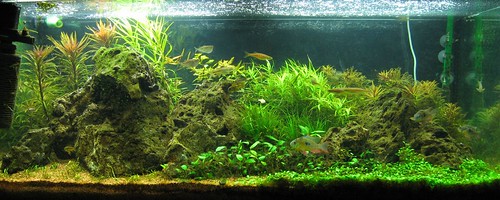
What I didn’t realize until after I put it in the tank, in that the rock has a natural cave in it, that’s just about perfect sized for a female apistogramma, but not quite large enough for the male. In essense, it’s the perfect size, and within a day of rescaping, one of the female A. cacatuoides took up residence.
So, besides the hardscape, I left the glosso intact on the right side of the tank before my previous scape. I repurposed the anubias baterii nana in front of the rocks in the middle, and replanted the utricularia on the left side. I’m a little curious to see if the U.V. sterilizer will have any effect on the growth rate of the utricularia. Finally, for the background, I went up to what has become a plant farm of my 40G, and trimmed out a variety of stems that I thought went together. From left to right: Pogostemon stellata ‘broadleaf’, Pogostemon sp., ludwigia repens ‘narrow-leaf’, Heteranthera zosterifolia, Blyxa japonica, and Limnophilia aromatica.
Posted in 75G Tank Log | 3 Comments »
January 9th, 2007

Thanks to some extra Christmas money, I decided to go ahead and get a U.V. Sterilizer for my 75G tank. I’ve been having a rash of green water, and a case of “something’s not right” situations in this tank for the past year, so I guess you could consider this my last resort.
After doing a fair amount of research on the web, I decided to go with Corallife’s Turbo-Twist Sterilizer. 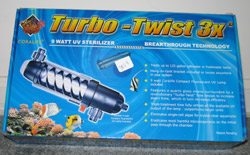 It seems to be a pretty popular product, and the price was right on Amazon.com. Setting the unit up was very easy using the instructions provided. Basically, you start by just unscrewing the one end to install the bulb. After that, you twist the middle section until the two barbs face in the direction that you need to connect to your filter. Finally, splice the output line of your filter, and connect either end of the line to the input and output barbs of the sterilizer. You’re done, once you plug it in.
It seems to be a pretty popular product, and the price was right on Amazon.com. Setting the unit up was very easy using the instructions provided. Basically, you start by just unscrewing the one end to install the bulb. After that, you twist the middle section until the two barbs face in the direction that you need to connect to your filter. Finally, splice the output line of your filter, and connect either end of the line to the input and output barbs of the sterilizer. You’re done, once you plug it in.
I was a little bit worried about the sterilizer affecting the flow-rate of my filter, but so far that hasn’t proven to be a problem. And that’s having a CO2 diffuser and in-line heater running on the filter with it. Of course, that why I bought an over-sized filter, Eheim 2028, for my 75G in the first place.
Twelve hours after hooking up the U.V. sterilizer, my tank appeared fairly cloudy, with a white, milky hue. I presume that consistuted a mass bacteria/bad thing die off after being zapped by the U.V. rays. By the second day, the water cleared, and it’s looked clearer than I can remember in recent history. I’m not entirely sure whether I’ll leave it running 24/7, or will turn it off to save the bulb-life a little bit, but I’m glad to know that I have a last resort available to rectify any extra difficult problems with my water column.
Posted in 75G Tank Log, Algae, Equipment | 2 Comments »







 I attended the
I attended the 




